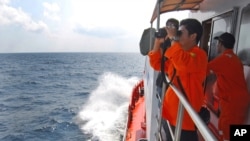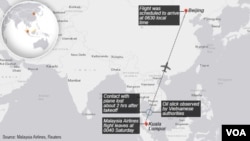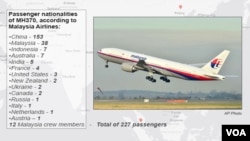HANOI —
Malaysia has again expanded the vast area where it is looking for a Boeing 777 jetliner with 239 people on board that went missing Saturday. Malaysian authorities acknowledge it is likely a search mission rather than a rescue effort.
Transport Minister Hishammuddin Hussein said ships and aircraft from 12 countries are now searching more than 90,000 square kilometers of water, and that the fifth day of the search, first focused on the Strait of Malacca and the South China Sea, now also extends far to the northwest to waters near India's Andaman and Nicobar islands.
The minister rejected criticism from some aviation experts outside Malaysia that the search has become mired in confusion, with Malay officials issuing contradictory reports about the effort.
On Tuesday Malaysia's Berita Harian newspaper quoted Air Force chief Rodzali Daud as saying, "The last time the flight was detected close to Pulau Perak, in the Melaka Straits, at 2:40 a.m. by the control tower before the signal was lost."
Pulau Perak is an island at the northern end of the Strait of Malacca.
But on Wednesday, Rodzali denied the military had tracked the missing flight in the vicinity of Pulau Perak.
“I request this misreporting be amended and corrected to prevent further misinterpretations of what is clearly an inaccurate and incorrect report,” Rodzali said in a statement.
Hishammuddin said officials have turned over military radar information to American air safety experts to try to determine whether Flight 370 reached the Strait of Malacca, hundreds of kilometers to the west from its last known sighting on civilian radar north of Malaysia. He said officials are still not sure whether the two radar systems are both detecting the missing jet.
Hishammuddin said authorities have an obligation to the families of those aboard the jet to find the missing aircraft.
"So many vessels and aircraft, so many countries to coordinate, and a vast area for us to search," he said. "And each time that passes, I fear that the search and rescue becomes just a search, but we will never give up hope. And this we owe to the families."
The minister said the country is dealing with an "unprecedented" situation and will do "whatever it takes" to find the Malaysia Airlines Boeing 777.
"My heart reaches out to the families of the passengers and crew, and I give you my assurance that we will not reduce the tempo and that we will not spare any effort to find the missing plane," he promised.
The minister said 42 ships and 39 aircraft from 12 countries have so far "found nothing" in their search, which now spans over 50,000 kilometers.
The last known signal detected from Malaysia Airlines flight MH370 was reported one minute before entering Vietnamese airspace, prompting a massive international search effort in the sea between Vietnam and Malaysia.
Vietnam scales back search
Amid the confusion over the possible whereabouts of the aircraft, Vietnam announced early Wednesday it was scaling back its search operations. But hours later, Deputy Chief of the General Staff of the Vietnam People's Army, Vo Van Tuan, said the search was back on.
He said search activities are being deployed as normal, expanding to the east and south of the plane’s last known trajectory between Vietnam and Malaysia.
Search teams have been scouring thousands of kilometers of water since Saturday without finding any trace of the missing plane.
In Hong Kong, Commander William Marks of the U.S. Navy’s 7th fleet said the effort is becoming more difficult.
"Time is not on our side. As every hour goes by, the search area gets bigger and bigger," he said. "From a typical standpoint, a person can survive in the water for at least 72 hours due to sheer willpower. A human being can survive without food or water if they are determined to survive. After that the chances of survival get less and less, and that's what we're concerned with right now."
Safety record
Despite the worldwide concern over the aircraft and bewilderment over how a plane could disappear in an age of instant communications, experts say flying has never been safer.
The International Civil Aviation Organization (ICAO) voted 2013 the safest on record in terms of fatalities involving commercial flights. Last year 173 people were killed in scheduled commercial flights, compared to 372 the previous year, according to the ICAO.
Greg Waldron, Asia managing editor of Flightglobal, a trade publication for the aviation sector says flying is safe.
“It’s completely safe to fly, I’m going to be flying tonight and I’m not even thinking twice about it. That’s why these things like MH370 are such a shock because they are so rare when they do happen,” he said.
He said it would be “a long road” before any answers the mystery of the fate of Flight MH370 are found.
Transport Minister Hishammuddin Hussein said ships and aircraft from 12 countries are now searching more than 90,000 square kilometers of water, and that the fifth day of the search, first focused on the Strait of Malacca and the South China Sea, now also extends far to the northwest to waters near India's Andaman and Nicobar islands.
The minister rejected criticism from some aviation experts outside Malaysia that the search has become mired in confusion, with Malay officials issuing contradictory reports about the effort.
On Tuesday Malaysia's Berita Harian newspaper quoted Air Force chief Rodzali Daud as saying, "The last time the flight was detected close to Pulau Perak, in the Melaka Straits, at 2:40 a.m. by the control tower before the signal was lost."
Pulau Perak is an island at the northern end of the Strait of Malacca.
But on Wednesday, Rodzali denied the military had tracked the missing flight in the vicinity of Pulau Perak.
“I request this misreporting be amended and corrected to prevent further misinterpretations of what is clearly an inaccurate and incorrect report,” Rodzali said in a statement.
Hishammuddin said officials have turned over military radar information to American air safety experts to try to determine whether Flight 370 reached the Strait of Malacca, hundreds of kilometers to the west from its last known sighting on civilian radar north of Malaysia. He said officials are still not sure whether the two radar systems are both detecting the missing jet.
Hishammuddin said authorities have an obligation to the families of those aboard the jet to find the missing aircraft.
"So many vessels and aircraft, so many countries to coordinate, and a vast area for us to search," he said. "And each time that passes, I fear that the search and rescue becomes just a search, but we will never give up hope. And this we owe to the families."
The minister said the country is dealing with an "unprecedented" situation and will do "whatever it takes" to find the Malaysia Airlines Boeing 777.
"My heart reaches out to the families of the passengers and crew, and I give you my assurance that we will not reduce the tempo and that we will not spare any effort to find the missing plane," he promised.
The minister said 42 ships and 39 aircraft from 12 countries have so far "found nothing" in their search, which now spans over 50,000 kilometers.
The last known signal detected from Malaysia Airlines flight MH370 was reported one minute before entering Vietnamese airspace, prompting a massive international search effort in the sea between Vietnam and Malaysia.
Vietnam scales back search
Amid the confusion over the possible whereabouts of the aircraft, Vietnam announced early Wednesday it was scaling back its search operations. But hours later, Deputy Chief of the General Staff of the Vietnam People's Army, Vo Van Tuan, said the search was back on.
He said search activities are being deployed as normal, expanding to the east and south of the plane’s last known trajectory between Vietnam and Malaysia.
Search teams have been scouring thousands of kilometers of water since Saturday without finding any trace of the missing plane.
In Hong Kong, Commander William Marks of the U.S. Navy’s 7th fleet said the effort is becoming more difficult.
"Time is not on our side. As every hour goes by, the search area gets bigger and bigger," he said. "From a typical standpoint, a person can survive in the water for at least 72 hours due to sheer willpower. A human being can survive without food or water if they are determined to survive. After that the chances of survival get less and less, and that's what we're concerned with right now."
Safety record
Despite the worldwide concern over the aircraft and bewilderment over how a plane could disappear in an age of instant communications, experts say flying has never been safer.
The International Civil Aviation Organization (ICAO) voted 2013 the safest on record in terms of fatalities involving commercial flights. Last year 173 people were killed in scheduled commercial flights, compared to 372 the previous year, according to the ICAO.
Greg Waldron, Asia managing editor of Flightglobal, a trade publication for the aviation sector says flying is safe.
“It’s completely safe to fly, I’m going to be flying tonight and I’m not even thinking twice about it. That’s why these things like MH370 are such a shock because they are so rare when they do happen,” he said.
He said it would be “a long road” before any answers the mystery of the fate of Flight MH370 are found.












